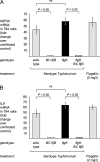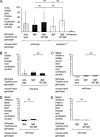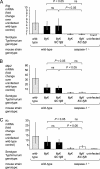Contribution of flagellin pattern recognition to intestinal inflammation during Salmonella enterica serotype typhimurium infection
- PMID: 19237529
- PMCID: PMC2681779
- DOI: 10.1128/IAI.01341-08
Contribution of flagellin pattern recognition to intestinal inflammation during Salmonella enterica serotype typhimurium infection
Abstract
Salmonella enterica serotype Typhimurium causes acute inflammatory diarrhea in humans. Flagella contribute to intestinal inflammation, but the mechanism remains unclear since most mutations abrogating pattern recognition of flagellin also prevent motility and reduce bacterial invasion. To determine the contribution of flagellin pattern recognition to the generation of innate immune responses, we compared in two animal models a nonmotile, but flagellin-expressing and -secreting serotype Typhimurium strain (flgK mutant) to a nonmotile, non-flagellin-expressing strain (flgK fliC fljB mutant). In vitro, caspase-1 can be activated by cytosolic delivery of flagellin, resulting in release of the interferon gamma inducing factor interleukin-18 (IL-18). Experiments with streptomycin-pretreated caspase-1-deficient mice suggested that induction of gamma interferon expression in the murine cecum early (12 h) after serotype Typhimurium infection was caspase-1 dependent but independent of flagellin pattern recognition. In addition, mRNA levels of the CXC chemokines macrophage inflammatory protein 2 and keratinocyte-derived chemokine were markedly increased early after serotype Typhimurium infection of streptomycin-pretreated wild-type mice regardless of flagellin expression. In contrast, in bovine ligated ileal loops, flagellin pattern recognition contributed to increased mRNA levels of macrophage inflammatory protein 3alpha and more fluid accumulation at 2 h after infection. Collectively, our data suggest that pattern recognition of flagellin contributes to early innate host responses in the bovine ileal mucosa but not in the murine cecal mucosa.
Figures







References
-
- Ahmer, B. M., J. van Reeuwijk, P. R. Watson, T. S. Wallis, and F. Heffron. 1999. Salmonella SirA is a global regulator of genes mediating enteropathogenesis. Mol. Microbiol. 31971-982. - PubMed
-
- Alaniz, R. C., L. A. Cummings, M. A. Bergman, S. L. Rassoulian-Barrett, and B. T. Cookson. 2006. Salmonella typhimurium coordinately regulates FliC location and reduces dendritic cell activation and antigen presentation to CD4+ T cells. J. Immunol. 1773983-3993. - PubMed
-
- Aldridge, P., J. Karlinsey, and K. T. Hughes. 2003. The type III secretion chaperone FlgN regulates flagellar assembly via a negative feedback loop containing its chaperone substrates FlgK and FlgL. Mol. Microbiol. 491333-1345. - PubMed
-
- Anderle, P., M. Rumbo, F. Sierro, R. Mansourian, P. Michetti, M. A. Roberts, and J. P. Kraehenbuhl. 2005. Novel markers of the human follicle-associated epithelium identified by genomic profiling and microdissection. Gastroenterology 129321-327. - PubMed
-
- Ausubel, F. M., R. Brent, R. E. Kingston, D. D. Moore, J. G. Seidman, J. A. Smith, and K. Struhl. 1994. Current protocols in molecular biology. J. Wiley & Sons, Inc., New York, NY.
Publication types
MeSH terms
Substances
Grants and funding
- AI040124/AI/NIAID NIH HHS/United States
- C06 RR12088-01/RR/NCRR NIH HHS/United States
- R01 AI076246/AI/NIAID NIH HHS/United States
- R01 AI044170/AI/NIAID NIH HHS/United States
- R29 AI040124/AI/NIAID NIH HHS/United States
- R01 AI040124/AI/NIAID NIH HHS/United States
- AI076246/AI/NIAID NIH HHS/United States
- R37 AI032738/AI/NIAID NIH HHS/United States
- AI079173/AI/NIAID NIH HHS/United States
- R21 AI079173/AI/NIAID NIH HHS/United States
- C06 RR012088/RR/NCRR NIH HHS/United States
- R01 AI050843/AI/NIAID NIH HHS/United States
- AI044170/AI/NIAID NIH HHS/United States
LinkOut - more resources
Full Text Sources
Medical
Molecular Biology Databases
Miscellaneous

